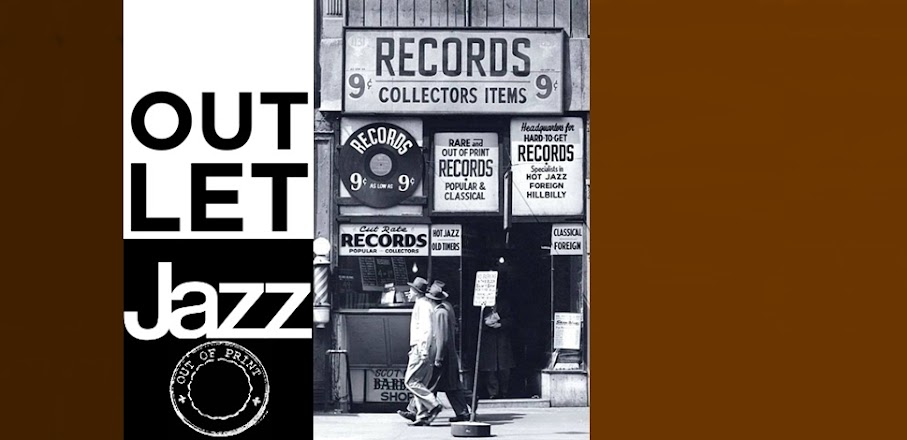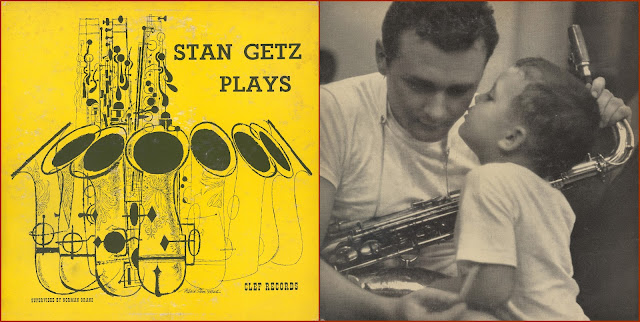The success of the Dave Pell Octet was one of the fairy-tale stories of the West Coast jazz of the Fifties. Founded by Pell in 1953, this small jazz group, drawn from the nucleus of Les Brown's orchestra, was among the most popular jazz outfits in Southern California within months. The Octet's first library had the stimulating and ingeniously voiced arrangements of Shorty Rogers and Wes Hensel, which gave this group the feel of a big band. "We used the guitar as a voice in unison with trumpet", Pell explained, "and so the Octet sound had a successful formula which allowed us to play a tempo that was danceable and yet still had a jazz feel".
Bill Brown, Daily News jazz columnist wrote: "Pell and his group have flipped fans everywhere they've appeared. It's a skilled and interesting group and one you should hear". The Octet's cohesion was remarkable, and additional scores by such talented arrangers as Marty Paich, Johnny Mandel, and Bill Holman, helped establish its sound and personality.
All of the Octet's recordings for the labels Trend (1953-1954) and Kapp (1956), which epitomize its smooth sophistication; with their tightly scored ensembles, the deft styling concealed some excellent musicianship, and they all contain highly individualistic contributions by its stellar soloists, Don Fagerquist, Ray Sims, Ronny Lang, and the airy, swinging tenor of Dave Pell, who said, simply: "We play jazz for dancing. That's our forte". *Jordi Pujol*
Mine is not the approach of a jazz musician who goes into the recording studio to play 40 minutes of completely improvised jazz. Our projects are carefully planned. I feel that our music should be well designed, interesting yet easy to follow. We find it best to state the melody first, then come the spots for the blowing. But even behind a jazz chorus I want backgrounds going at the same time to give an overall big band sound. The restatement of the melody, in one form or another, in the closing completes the pattern. *Dave Pell*
The Dave Pell Octet
The Complete Trend And Kapp Recordings
1953 ~ 1956
Back in the 1950s, a group of guys from New York and Philadelphia moved to Hollywood to get steady work in the nascent TV and movie recording industry and developed a sound called "West Coast Cool". Essentially, is was a reaction to the torrid tempos and harmonics of bebop; a kinder, gentler sound, more adaptable to cruising along Pacific Coast Highway in your convertible while wearing your Hawaiian shirt. The softer and more arranged sounds have been denigrated by some, but they have surprisingly aged well, especially when the music was in the capable hands of Pres-inspired tenor saxist Dave Pell, who faithfully carried the lighter than sound air and kept it popular until it was finally taken over by the cacophonous shrieks and wails by the barbarians at the gates in the late 50s and early 60s.
This two disc set has the soft and sleek toned tenorist with fellow Angelenos including Don Fagerquist, Ray Sims, Ronny Lang, Jeff Clarkson, Don Trenner, Claude Williamson, Tony Rizzi, Rolly Rundock, Bill Richmond and Jack Sperling. The polished chrome arrangements are by the likes of Marty Paich, Shorty Rogers, Johnny Mandel, Med Flory, and Bill Holman among others. The themes of the three albums produced here give tributes to composers Irving Berlin, Rodgers & Hart and Burke & Van Heusen.
Vocalist Lucy Ann Polk gives girl next door versions of daiquiri-flavored "Like Someone In Love", "Polka Dots and Moonbeams" and "Aren't You Glad You're You". Pell himself is lithe and warm as he coos on "I'm Putting All My Eggs in One Basket" and "Kate". Pell adds some rich harmonics as he switches to the English horn on "Russian Lullaby" and Ronny Lang wisps on the flute during "It Never Entered My Mind" and "Darn that Dream". The team is light enough to swing with soft shoes, but thick enough to show some muscle in the process, and the creative charts keep the music concise, coherent and clever.
The liner notes include all of the studio info, as well as some great background on a period when a jazzer could make a good living and buy a house in the Valley just by blowing his horn. Any complaints? *George W. Harris*
The Dave Pell Octet was one of the definitive cool jazz groups of the 1950s. Tenor saxophonist Pell played with Les Brown's big band during 1948-56 and started to record with an octet drawn from the orchestra in 1953. His first project was a set of a dozen Irving Berlin tunes, and the results are quite memorable. The swinging and subtle ensembles, concise and emotionally restrained solos, and excellent musicianship would be trademarks of the band. Consisting of Pell; trumpeter Don Fagerquist; trombonist Ray Sims; Ronny Lang on baritone, alto, and flute; pianist Jeff Clarkson; guitarist Tony Rizzi; bassist Rolly Bundock; and drummer Jack Sperling, the octet plays arrangements by Shorty Rogers, Jerry Fielding, and Wes Hensel. Recommended.
The Rodgers & Hart set was one of the group's most famous recordings, with classic renditions of "Mountain Greenery", "The Blue Room", "Spring Is Here" and "Ten Cents a Dance" being among the highpoints. The arrangements (by Marty Paich, Wes Hensel, Shorty Rogers, and Johnny Mandel) practically define the idiom, as do the cool-toned solos. A gem.
This release reissues the band's two Johnny Burke/Jimmy Van Heusen albums. Lucy Ann Polk sings eight of the 16 selections, and she is a major asset, displaying a relaxed, straightforward, basic, and winning approach, warmly uplifting each song. The arrangements are by Shorty Rogers, Wes Hensel, Bill Holman, Bob Enevoldsen, Jack Montrose, Med Flory, Jim Emerson, and Buddy Bregman. The octet sounds at its best on "But Beautiful", "Suddenly It's Spring", "It's Always You", "Aren't You Glad You're You", "It Could Happen to You", and "Imagination". Timeless music. *Scott Yanow*
*CD 1*
1 - I'm Putting All My Eggs In One Basket
2 - Change Partners
3 - Love And The Weather
4 - Russian Lullaby
5 - Kate
6 - Say It With Music
7 - I Used To Be Color Blind
8 - Let's Have Another Cup Of Coffee
9 - Better Luck Next Time
10 - They Say It's Wonderful
11 - This Year's Kisses
12 - He Ain't Got Rhythm
13 - Why Do You Suppose?
14 - Have You Met Miss Jones?
15 - You Are Too Beautiful
16 - Mountain Greenery
17 - A Ship Without A Sail
18 - The Blue Room
19 - I've Got Five Dollars
20 - Sing For Your Supper
21 - It Never Entered My Mind
22 - The Lady Is A Tramp
23 - Spring Is Here
24 - Ten Cents A Dance
(#1 to #12: All compostions by Irving Berlin)
(#13 to #24: All compostions by Richard Rodgers and Lorenz Hart)
*CD 2*
1 - But Beautiful
2 - My Heart Is A Hobo
3 - Like Someone In Love
4 - Swinging On A Star
5 - Suddenly It's Spring
6 - It's Always You
7 - What Does It Take
8 - Aren't You Glad You're You
9 - All This And Heaven Too
10 - It Could Happen To You
11 - Just My Luck
12 - Imagination
13 - When Is Sometime
14 - Darn That Dream
15 - Humpty Dumpty Heart
16 - Polka Dots And Moonbeams
(All compositions by Johnny Burke and Jimmy Van Heusen, except #14 by Johnny Burke, Jimmy Van Heusen and Eddie De Lange)
#1 to #12 (CD1):
Don Fagerquist (trumpet), Ray Sims (trombone, vocals [#10]), Ronny Lang (baritone sax, alto sax [#6, #11], flute [#4]), Dave Pell (tenor sax, English horn [#4], Jeff Clarkson (piano), Tony Rizzi (guitar), Rolly Bundock (bass), Jack Sperling (drums).
Recorded at Radio Recorders, Hollywood, California, April 22 (#3 to #6) and May 28, (#8 to #11), 1953; May 14 (#1, #2, #7, #12), 1956
#13 to #24 (CD1):
Don Fagerquist (trumpet), Ray Sims (trombone), Ronny Lang (baritone sax, flute [#21]), Dave Pell (tenor sax, bass clarinet [#23]), Donn Trenner (piano, celeste [#15]), Tony Rizzi (guitar), Rolly Bundock (bass), Bill Richmond (drums).
Recorded at Capitol Studios, Hollywood, California, June 11, 21 and 24, 1954
#1 to #16 (CD2):
Don Fagerquist (trumpet), Ray Sims (trombone), Ronny Lang (baritone sax, flute [#6, #14, #16]), Dave Pell (tenor sax, English horn [#6, #14, #16]), Claude Williamson (piano, celeste [#14, #16]), Tony Rizzi (guitar), Rolly Bundock (bass), Jack Sperling (drums), Lucy Ann Polk (vocals [#1, #4, #6, #8, #10, #12, #14, #16]).
Recorded at Radio Recorders, Hollywood, California, December 18 (#1, #4, #6, #8, #10, #12, #14) and December 28 (#16), 1953; May 7 (#2, #3, #5, #7, #9, #11, #13) and May 21 (#15), 1956
#1, #2, #7 and #12 (CD1): from "The Dave Pell Octet Plays Irving Berlin" (Kapp KL-1036)
#3 to #6 and #8 to 11 (CD1): "The Dave Pell Octet Plays Irving Berlin" (Trend TL-1003)
#13 to #24 (CD1): "The Dave Pell Octet Plays Rodgers & Hart" (Trend TL-1501, reissued as Kapp KL-1025)
#1, #4, #6, #8, #10, #12, #14 and #16 (CD2): "Dave pell Octet · Lucy Ann Polk" (Trend TL-1008)
#2, #3, #5, #7, #9, #11, #13 and #15 (CD2): "The Dave Pell Octet Plays Burke & Van Heusen" (Kapp KL-1034)

















